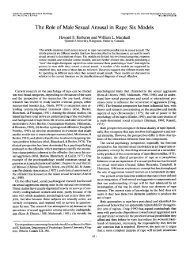Regulation of the dopamine transporter - Addiction Research ...
Regulation of the dopamine transporter - Addiction Research ...
Regulation of the dopamine transporter - Addiction Research ...
Create successful ePaper yourself
Turn your PDF publications into a flip-book with our unique Google optimized e-Paper software.
DAT <strong>Regulation</strong> Schmitt & Reith<br />
Figure 1. The many parallel factors influencing DAT trafficking and membrane distribution. (A) The DAT undergoes<br />
continuous constitutive recycling between <strong>the</strong> plasma membrane and early endosomal compartments. (B) and (C)<br />
Substrates, such as amphetamine trigger internalization <strong>of</strong> plasmalemmal DATs, whereas cocaine-like inhibitors<br />
upregulate surface DAT expression. (D) and (E) Alterations in <strong>the</strong> phosphorylation state <strong>of</strong> DAT and associated<br />
scaffolding proteins by intracellular signaling cascades modulates <strong>transporter</strong> trafficking—although direct phosphorylation<br />
<strong>of</strong> DAT proteins is probably not caused by PKC, this kinase is an integral participant in DAT dynamics. (F)<br />
Physical coupling <strong>of</strong> <strong>the</strong> DAT to <strong>dopamine</strong> D2 receptors encourages recruitment <strong>of</strong> DAT to <strong>the</strong> plasma membrane.<br />
(G) PKC is also involved in ubiquitin-mediated DAT regulation, with monoubiquitination hypo<strong>the</strong>sized to target<br />
internalized DAT to <strong>the</strong> lysosomal degradation pathway. (In color in Annals online.)<br />
DAT. Moreover, as Deken et al. have proposed, <strong>the</strong><br />
ability to rapidly alter <strong>transporter</strong> trafficking may<br />
allow cells to regulate <strong>the</strong> exocytic release <strong>of</strong> neurotransmitters<br />
and <strong>the</strong> insertion <strong>of</strong> surface <strong>transporter</strong>s<br />
in parallel. 19 This hypo<strong>the</strong>sis was prompted<br />
by <strong>the</strong> finding that <strong>the</strong> GABA <strong>transporter</strong> (GAT1)<br />
is trafficked to and from <strong>the</strong> plasma membrane in<br />
recycling vesicles similar in size and morphology<br />
to synaptic vesicles (but lacking synaptophysin and<br />
<strong>the</strong> vesicular GABA <strong>transporter</strong>) and that <strong>the</strong> rate<br />
<strong>of</strong> recycling depends on intracellular Ca 2+ concentration,<br />
indicating that <strong>transporter</strong> trafficking may<br />
indeed be coupled to transmitter release. 19<br />
<strong>Regulation</strong><strong>of</strong>DATactivitycanbetriggeredby<br />
a myriad <strong>of</strong> exogenous factors and cellular events,<br />
such as (1) small-molecule ligands targeting ei<strong>the</strong>r<br />
<strong>the</strong> DAT itself (i.e., substrates and inhibitors) or<br />
presynaptic G protein-coupled receptors (GPCRs)<br />
that affect DAT, (2) enzymatic modification (e.g.,<br />
phosphorylation) involving intracellular secondmessenger<br />
cascades, and (3) protein–protein<br />
interactions between <strong>the</strong> DAT and o<strong>the</strong>r transmembrane<br />
or cytoskeletal scaffolding proteins. A graphical<br />
overview <strong>of</strong> <strong>the</strong> putative factors influencing<br />
DAT membrane trafficking is given in Figure 1. Our<br />
primary focus in this review will be on short-term<br />
DAT regulation in response to acute exposure to psychostimulants,<br />
such as cocaine- and amphetaminelike<br />
drugs. Although <strong>the</strong> complete signaling mechanisms<br />
underlying substrate- and inhibitor-mediated<br />
318 Ann. N.Y. Acad. Sci. 1187 (2010) 316–340 c○ 2010 New York Academy <strong>of</strong> Sciences.










